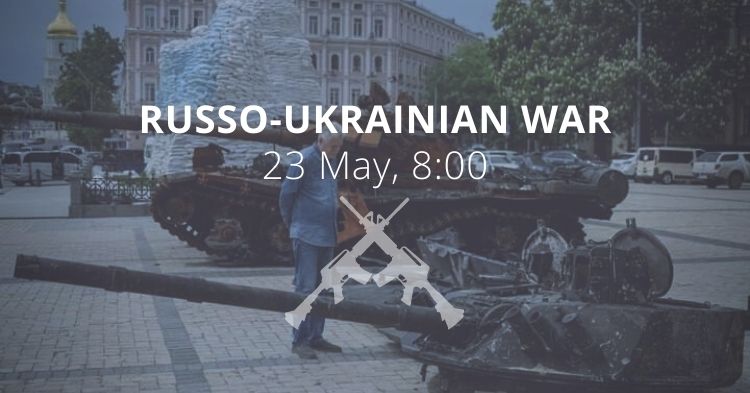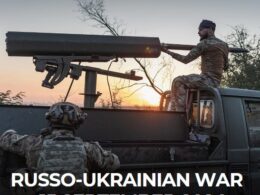Ukraine slows down Russian advance on Sievierodonetsk, key Donbas city under attack. Russia tries to thwart Ukrainian attempts to recapture Izium and prepares assault on south Ukraine. Russian troops used 350 hostages as a human shield for their military headquarters. including a 1.5 month-old baby. Ukraine rules out a ceasefire and territorial concessions to Russia, dismissing "very strange" calls West for an urgent ceasefire and urging for Russia's "painful defeat." Poland's president calls on EU to open doors to Ukraine in June.
Situation
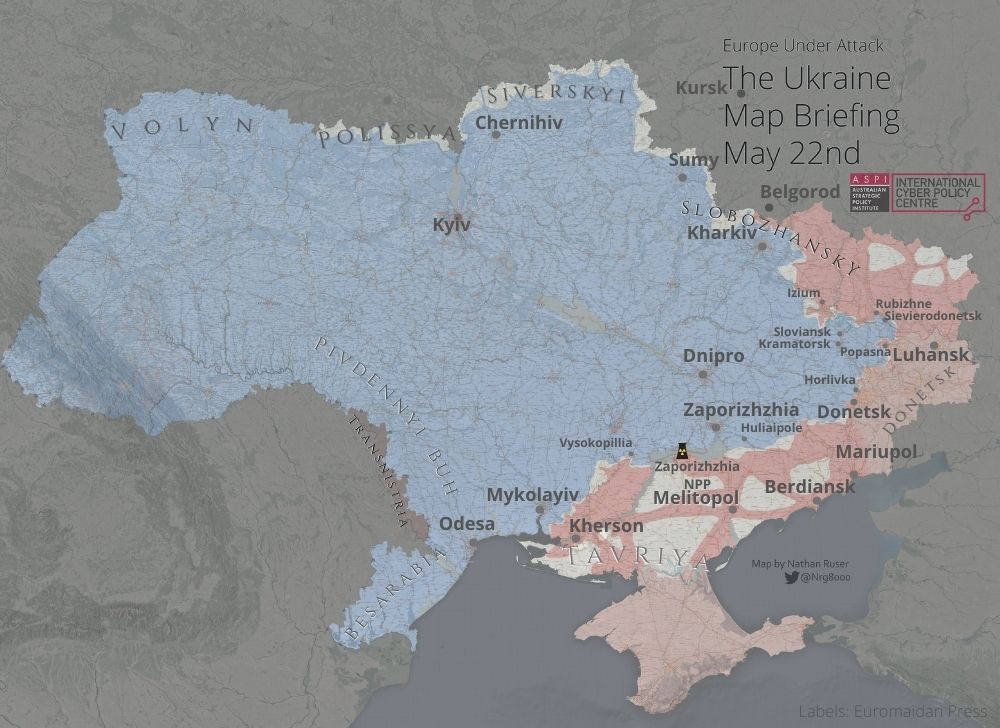
A short overview of developments at the front as of the evening of 22 May 2022 according to military expert Roman Ponomarenko:
The Russians continue to bomb Ukrainian territory, while their offensive in Luhansk Oblast has slowed down.
No change in Kharkiv Oblast and Sloviansk. The Russian shelling attacks and "reconnaissance by battle" continue as the Russian troops are preparing to resume the offensive.
A map of the approximate situation on the ground in Ukraine as of 00:00 UTC 23/05/22.
There have been no notable changes to control since the last update. pic.twitter.com/VObQekw1ZU
— War Mapper (@War_Mapper) May 23, 2022
Russia still seeks to encircle Sievierodonetsk in Luhansk Oblast. Russian troops destroyed the Pavlohrad bridge between Sievierodonetsk and Lysychansk on 21 May, though Sievierodonetsk hasn't yet been cut off as there's one more bridge over the Siverskyi Donets river. Russian forces continued to storm Ukrainian positions south and north of Sievierodonetsk almost non-stop. Scenarios to retreat from Sievierodonetsk are likely to be considered in the Ukrainian HQ.
Ukrainian troops stopped the Russian offensive in the area of Popasna, preventing the Russians from reaching the Soledar-Lysychansk highway. The Russian units are establishing themselves east of Soledar (Donetsk Oblast) about 2 kilometers south of the villages of Vasylivka and Lypove and in the area of Volodymyrivka. On the approaches to Bakhmut (Donetsk Oblast), the Russian forces were stopped near Pylypchatyne.
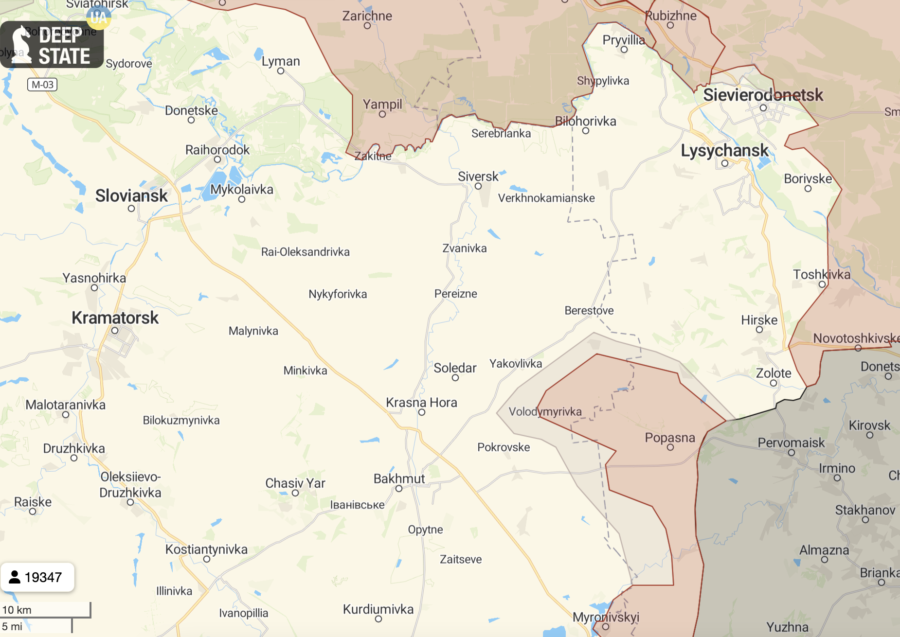
To the north of Popasna, Ukrainian troops stopped the Russians on the line Komyshuvakha - Viktorivka - Lypove with Vrubivka reportedly remaining under Ukrainian control.
The situation in this sector of the front is still far from complete stabilization and Russian attacks are likely to intensify in the coming days.
https://twitter.com/WarMonitor3/status/1528135519191851014
No significant changes in the rest of Donetsk Oblast. Fighting continues in Novobakhmutivka and Novoselivka Druha as Russians keep trying to push the Ukrainian Armed Forces away from Horlivka with no success, unable to reach even Niu York only a few kilometers away from Horlivka. In other areas, from Donetsk to Velyka Novosilka, the situation hasn't changed either. The General Staff recorded fewer hostilities in the Avdiivka and Kurakhove areas.
Russia masses troops in Ukraine's south. A number of international observers report the concentration of Russian troops in Kherson and Zaporizhzhia oblasts and predict a Russian offensive in the near future to capture the northern areas of Kherson Oblast and advance on Zaporizhzhia. Russia is amassing troops near Vysokopillia and Arkhanhelske in Kherson Oblast and in Inzhenerne south of Huliaipole in Zaporizhzhia.
Belarus continues its saber-rattling on the northern Ukrainian border, claiming that Ukraine has sent saboteur groups to Belarus. Lukashenka is also moving Iskander missile systems towards the Ukrainian border. Roman Ponomarenko believes that it is unlikely that Lukashenka will risk attacking Ukraine now.
Morning report day 89 – May 23
The report is based on media reports, expert analyses and official information posted online.
Information from the General Staff as of 06.00 23.05.2022, supplemented by its [18:00 assessment] is the drop-down box below.
Russian forces continue to launch missiles and airstrikes on the territory of Ukraine. Increased the intensity of the use of aircraft to destroy the critical infrastructure of settlements in the area of active hostilities.
In the Volyn and Polissia directions, the armed forces of the Republic of Belarus are conducting intensive reconnaissance and additional units are being deployed in the border areas of the Gomel region. The threat of air and missile strikes from the territory of the Republic of Belarus remained.
The situation in the Siverskyi direction has not changed significantly.
- [Russian forces are tightening control over the Ukrainian-Russian border in the Bryansk and Kursk regions. The enemy is conducting demonstration actions to prevent the movement of our troops' reserves to the Eastern Operational Zone. Continues shelling of settlements and civilian infrastructure in Sumy and Chernihiv oblasts.]
[In the Slobozhanskyi direction, Russian forces are carrying out systematic artillery shelling of the positions of our troops. To increase the efficiency of the transfer of troops and cargo, measures are being taken to restore the railway infrastructure in the area of Kupiansk.]
- In the Slobozhanskyi direction, Russian forces, including the 6th Combined Arms Army of the Western Military District and the Baltic Fleet, are fighting to maintain the previously occupied frontiers in the Kharkiv direction. Strengthening the police-administrative regime, enemy units set up checkpoints and fortifications on access roads and directly near the settlements of Velykyi Burluk, Kapitolivka, Mykhailivka, Levkivka, Zabavne and Kupiansk.
- [Russian forces did not take any active action in the Kharkiv direction during the day. Strengthened the police and administrative regime in the temporarily occupied territories.]
- [In the Sloviansk direction, the occupiers focused their efforts on creating conditions for the resumption of the offensive. The shelling of settlements along the line of contact continued. In some areas, they tried to conduct reconnaissance by fighting, suffered losses and retreated.]
- With the help of separate units of the Western Military District, the 11th Army Corps of the Baltic Fleet and the Eastern and Central Military Districts, Russian forces are preparing to resume the offensive in the Sloviansk direction. It attempted offensive operations in the area of Dovhenke. This offensive was repulsed by units of the Defense Forces, Russian forces suffered losses and retreated.
In the Donetsk direction, Russian forces do not stop trying to break through the defenses of Ukrainian troops and reach the administrative borders of Luhansk oblast.
- It did not conduct active hostilities in the Lyman direction. The occupiers fired on the infrastructure in the areas of the settlements of Lyman, Ozerne and Dibrova.
- In the Sievierodonetsk direction, Russian forces concentrated their efforts in the direction of the settlement of Sievierodonetsk. It conducted assault operations in the Toshkivka area. [Yesterday, Russian forces fought in the area of the settlement of Prudivka. The occupying forces also tried to launch an offensive to capture the village of Oleksandrivka but were unsuccessful.]
- In the Bakhmut direction, with the support of artillery, Russian forces fought in the area of Alexandropil. As a result of the fire defeat by the Defense Forces, Russian forces suffered losses and retreated. It led the offensive in the areas of Lypovo and Trypillya, without success. [Yesterday, Russian occupiers tried to improve the tactical position of their units. They fought in the settlements of Toshkivka, Komyshuvakha, Trypillya and Vasylivka.]
- In the Avdiivka, Kurakhove, Novopavliv and Zaporizhzhia directions there is a decrease in the intensity of hostilities. Russian forces are trying to gain a foothold on the achieved frontiers, shelling the positions of the Defense Forces. Russian forces inflicted airstrikes on civilian infrastructure in the areas of the settlements of Avdiivka, Novoselivka Druha, Novomykhailivka and Mykilske.
- Over the past 24hrs, eleven Russian forces attacks have been repulsed in the Donetsk and Luhansk directions, six tanks, ten units of armored combat vehicles and six units of enemy vehicles have been destroyed. Air defense units shot down one Orlan-10 UAV and an enemy Su-25 aircraft in these areas.
Russian forces did not conduct active hostilities in the Pivdennyi Buh direction. Focuses its main efforts on maintaining occupied frontiers, conducting reconnaissance and engineering activities of positions. It fired at the positions of the Defense Forces with artillery and MLRS. [Continues to build a second line of defense. Strengthens the artillery group and increases the air defense system.]
- [In the Besarabian direction, in the Transnistrian region of the Republic of Moldova, the situation remains tense. Personnel of units of the operational group of Russian troops continue to be on high alert. The main efforts of the occupiers are to keep weapons and military equipment ready for use. The inspection of local armed groups was carried out.]
[In the Black Sea and the Sea of Azov, Russian forces and naval groups continue to carry out tasks to isolate combat areas and block civilian shipping.]
As a result of losses during hostilities, Russian forces were forced to withdraw T-62 tanks from storage to recruit reserve battalion tactical groups that are being formed to be sent to Ukraine. In addition, equipment that was damaged and restored at repair and renovation plants is used to replenish the loss of weapons and military equipment.
Air and anti-aircraft missile units of the Air Force destroyed four enemy cruise missiles.”
In Donetsk and Luhansk, the Ukrainian Armed Forces destroyed more than 200 units of Russian equipment in a week, the Ukrainska Pravda reports. The Joint forces repulsed 84 invaders’ attacks in the past week. One anti-aircraft missile system, 43 tanks, 20 artillery systems (including 4 MLRS), 79 units of armored combat vehicles, 7 special armored vehicles and 34 units of motor vehicles were destroyed. Air defense units shot down three planes and 18 unmanned aerial vehicles of the occupier, the Joint Forces Task Force claimed.
https://twitter.com/EuromaidanPress/status/1528726843234594816
In the Donbas, the Armed Forces bombed the occupiers' crossing of the Siverskyi Donets, the Ukrainska Pravda reports, citing the Ministry of Internal Affairs. “In the east of Ukraine, Ukrainian artillerymen, thanks to border guards' intelligence, [again] destroyed the pontoon crossing of the Russian occupiers while a Russian tank was moving along it.”
Yet another failed attempt by Russia to cross Siverskyi Donets river in attempts to seize Sievierodonetsk. This time near Serebrianka, near previous disastrous try at Bilohorivka. Just started building pontoon bridge when hit by Ukrainian artillery
🎥https://t.co/uCVDUstRHS pic.twitter.com/5SsXj7a4s4— Euromaidan Press (@EuromaidanPress) May 22, 2022
Right-wing extremists take part in the attack on Ukraine, the NTV reports. “Russian President Putin has repeatedly justified the invasion of Ukraine by wanting to "de-Nazify" the country. According to a confidential report by the Federal Intelligence Service (BND), numerous Russian right-wing extremists and neo-Nazis are fighting on the side of Russia against Ukraine. According to the seven-page document, the "Russian Imperial League" and the group "Rusich" are "at least two groups with right-wing extremist sentiment" fighting against the Ukrainian army, as the "Spiegel" reports, citing the paper. In addition, Moscow uses at least one right-wing extremist "individual for its own purposes". Cooperation with these groups "reduces ad absurdum the alleged reason for war, the so-called 'denazification' of Ukraine," write the analysts.”
According to British Defence Intelligence, (last 24 hours):
- In the first three months of its ‘special military operation’, Russia has likely suffered a similar death toll to that experienced by the Soviet Union during its nine year war in Afghanistan.
- A combination of poor low-level tactics, limited air cover, a lack of flexibility and a command approach which is prepared to reinforce failure and repeat mistakes has led to this high casualty rate, which continues to rise in the Donbas offensive.
- The Russian public has, in the past, proven sensitive to casualties suffered during wars of choice. As casualties suffered in Ukraine continue to rise they will become more apparent and public dissatisfaction with the war and a willingness to voice it may grow.
As of Monday 23 May
, the approximate losses of weapons and military equipment of the Russian Armed Forces from the beginning of the war to the present day:
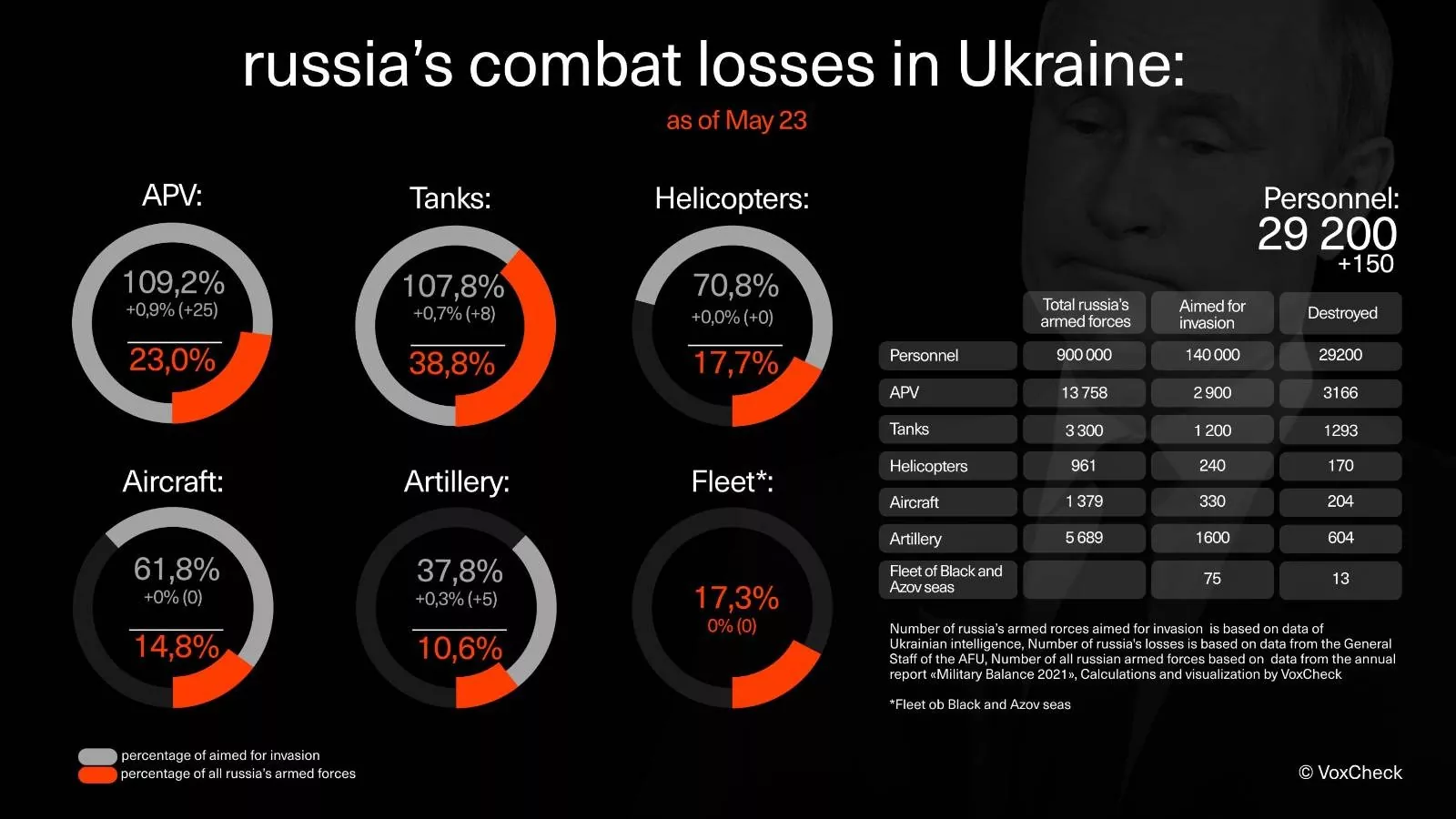
Russians suffered the greatest losses (of the last day) in the Bakhmut direction.
Humanitarian
Lyudmila Denisova, Ukraine’s human rights ombudswoman, warned in a post on the Telegram messaging app that Sievierodonetsk is becoming “a new Mariupol”, The Washington Post reports.
“The occupiers are trying to surround the Ukrainian-controlled part of the Luhansk region, turning it into a ruin of the city, which is protected from invaders. Enemy attacks are constantly being carried out in many areas and settlements are being shelled by invaders from artillery and volley fire systems.
The enemy threw all his forces to storm Sievierodonetsk, on the outskirts of which there are constant battles. The city is being transformed into a new Mariupol.
Yesterday, the ruscists purposefully shelled a school in the basement of which about 200 residents of Sievierodonetsk have been hiding since the beginning of the war. Three were killed and three others were injured.
The enemy is trying to capture the highway Lysychansk - Bakhmut, which is called the "road of life". This will block the evacuation of civilians and the delivery of humanitarian aid.
The killing of civilians and the shelling of peaceful cities and civilian objects by the aggressor's army with weapons strictly prohibited by international humanitarian law are war crimes and crimes against humanity under Articles 7 and 8 of the Rome Statute of the International Criminal Court and gross violations of the four Geneva Conventions of 1949 and additional protocols to them.
I appeal to the UN Commission for Investigation of Human Rights Violations during the Russian military invasion of Ukraine to take into account these facts of crimes and human rights violations in Ukraine. I call on international partners to provide weapons to fight the aggressor country of Russia!”
According to UNHCR 6,444,009 refugees have been registered as of May 20 (no update). The UN says that so far Poland has taken in 3,463,320 refugees, Romania 943,015, Russian Federation 887,651, Hungary 633,219, Republic of Moldova 468,998, Slovakia 435,660 and Belarus 27,308. Among those who fled Ukraine are also Ukrainian nationals with dual citizenship. An additional 105,000 people moved to the Russian Federation from Donetsk and Luhansk oblasts between 18 and 23 February.
The number of Ukrainians entering Ukraine since February 28 is 1,963,500 as of May 20. This figure reflects cross-border movements, which can be pendular and does not necessarily indicate sustainable returns.
OHCHR recorded 8,189 civilian casualties in Ukraine as of May 19 (no update). 3,838 were killed (including 256 children) and 4,351 injured (including 383 children).
Environmental
National Guard’s deminers neutralize about 10,000 explosive munitions in Kyiv Region, the Ukrinform reports. “The National Guard’s deminers are continuously clearing mines in Kyiv Region. Currently, they have revealed and neutralized about 10,000 explosive items. On some days, the deminers find several hundred dangerous munitions left behind by Russian occupiers,” the report states. The relevant statement was made by the Ukrainian Internal Affairs Ministry on Telegram, an Ukrinform correspondent reports. According to the ministry, there are munitions prohibited by the Geneva Convention among those found by the National Guard.”
Ukraine’s culture minister says the war has damaged hundreds of cultural sites, The New York Times reports. “Ukraine’s culture minister said Sunday that Russian forces have destroyed or damaged more than 350 cultural and historic sites since invading the country in late February. The constant shelling, rockets and bombings have destroyed 21 monuments of national significance, 88 of local importance and seven recently discovered heritage sites, he said. We are already working with international partners on a plan to protect our cultural heritage.”
Legal
Mykolaiv is being shelled with cluster bombs – Mayor, the Ukrainska Pravda reports. On Sunday evening, the Russian troops are shelling Mykolaiv with cluster bombs – the Mayor Olexander Sienkevych reports on Telegram.
Russian military used 350 hostages in Yahidne village as a human shield, the Ukrinform reports. According to the Prosecutor General’s Office, the employees of the Chernihiv Regional Prosecutor's Office made a joint trip with experts from the Office of the Prosecutor of the ICC to the village of Yahidne. “
It was preliminarily established that from March 3 to March 31, the invaders held civilians in the basement of the Yahidne branch of the Kulychiv secondary school of the Ivanivka Village Council. "In fact, the people, held in the basement, were used as human shields because the school was the headquarters of the Russian military," the PGO stressed.
It is noted that more than 350 locals, including 77 children with 5 infants among them, were held in a room of 197 square meters for almost a month. The youngest child was one and a half months old and the oldest hostage was 93 years old. Due to inhumane conditions – lack of sufficient space, sanitation, access to air, food, water – ten elderly people died.”
 232 children were killed and 431 children injured, the Office of the Prosecutor General of Ukraine reports
232 children were killed and 431 children injured, the Office of the Prosecutor General of Ukraine reports
as of May 23. 1,837 educational establishments are damaged as a result of shelling and bombings, 172 of them are destroyed fully. 13,341 crimes of aggression and war crimes and 6,202 crimes against national security were registered.
Support
The President of Poland stresses the need for continued support for Ukraine, the Ukrainska Pravda reports."President Duda stressed that the world must continue supplying Ukraine not just with humanitarian aid, but also with weapons and that it mustn’t stop doing so – otherwise the Russian aggression will threaten the entire world. He added that the only way to hasten a peaceful outcome for Ukraine is to further isolate Russia from the rest of the world and to tighten sanctions against it and not to put pressure on Ukraine to agree to the occupiers’ disgraceful compromises.
Duda criticised those member-states of the European Union that delay and obstruct another round of sanctions against Russia, which would bring Europe closer to the embargo of Russian energy.”
EU should open doors to Ukraine in June – Duda, the Ukrinform reports. “Today Ukraine needs our signal to open European doors for Ukraine as a state, for Ukrainian society that wants to be part of the European community and not Russia’s sphere of influence,” the Polish President Andrzej Duda stated during a joint press conference with Ukrainian President Volodymyr Zelenskyy in Kyiv. “In his words, granting EU candidate status to Ukraine at a summit of the European Council on June 24, 2022, would be a signal for Ukrainians from the European leaders and have an important political and psychological effect.”
NZ to provide additional deployment to support Ukraine, a statement on the official website of the New Zealand Government says. “As part of New Zealand’s ongoing response to the war in Ukraine, New Zealand is providing further support and personnel to assist Ukraine to defend itself against Russia’s unprovoked and illegal invasion, Prime Minister Jacinda Ardern announced today. A New Zealand Defence Force (NZDF) artillery training team of up to 30 personnel will be deployed to the United Kingdom to help train Ukrainian military personnel in operating L119 105mm light field guns, Jacinda Ardern said. Our training team has been requested to help train members of Ukraine’s Armed Forces in the use of the weapon system until the end of July.”
Russian military hardware getting wrecked in Ukraine could hurt its appeal to some of Moscow's best customers, the Insider reports. Images of wrecked and abandoned vehicles — casualties in Moscow's invasion of Ukraine — are calling into question the quality and reliability of Russian-made military hardware.
A recent report by the Singapore-based ISEAS-Yusof Ishak Institute found that the conflict has damaged the reputation of Russia's defense equipment in Southeast Asia, once a source of considerable revenue for the country.
Russia has been the largest exporter of arms to Southeast Asia over the past two decades, but since 2014, the value of its defense sales to the region has plummeted. The Ukraine war will make it difficult for its defense industry to revive sales and is likely to lead to further declines in arms exports to Southeast Asia, according to the report's author, Ian Storey, a senior fellow at the ISEAS-Yusof Ishak Institute.
The equipment reportedly destroyed on the battlefield includes tanks also used by Vietnam and Laos, infantry fighting vehicles and armored personnel carriers used by Indonesia and military attack and transport helicopters used by multiple Southeast Asian countries, Storey said.
Russian equipment has always had a reputation for being fairly cheap but pretty reliable. But now, Abuza said, that is "proving to be less true.
In Southeast Asia, it ranks No 1. Between 2000 and 2021, the value of Russia's arms exports to the region was US$10.87 billion, followed by the United States (US$8.4 billion), France (US$4.3 billion) and Germany (US$2.94 billion) and China (US$2.9 billion).
Given the war and sanctions, all Southeast Asian countries that currently rely on Russia for major military equipment will be vulnerable to the potential disruption in spare parts supply, [Collin Koh, a research fellow at Singapore's S. Rajaratnam School of International Studies] warned. With few exceptions, most buyers of Russian major military equipment heavily depend on Moscow for spare parts as part of after-sales service support.
New developments
- Ukraine's parliament extends martial law and mobilization until Aug 23, the Ukrinform reports. The Verkhovna Rada has extended martial law and general mobilization in Ukraine for 90 days, until August 23.
- Boris Johnson discussed Russia's blockade of Odesa with Ukraine's Zelensky, the Reuters reports. “UK Prime Minister Boris Johnson on Sunday discussed with Ukrainian President Volodymyr Zelenskyy Russia's blockade of Ukraine's shipping port Odesa, a Downing Street spokesperson said. Johnson resolved to redouble efforts to provide vital food and humanitarian aid to the people of Ukraine and ensure the country was able to export to the rest of the world, the spokesperson added.”
- Medinsky again complains that Ukraine is blocking the negotiations, the Ukrainska Pravda reports. "We, for our part, are ready to continue the dialogue. But I would like to emphasise once again: that the ball for continuing the peace talks is on the Ukrainian side. Freezing negotiations is entirely an initiative of Ukraine," the head of the Russian negotiating group, Vladimir Medinsky, said on the Belarusian TV channel "Belarusian National Television". He claimed that the Russian negotiating group sent written responses to the draft agreement that was proposed by Ukraine on 29 March in Istanbul. [ME: It's quite telling that while Ukraine complained about lack of progress in the first phase, Russia is increasingly the part complaining as Ukraine has started counterattacking.]
- President’s Office: Ukraine rules out ceasefire or territorial concessions to Russia, the Ukrinform reports. “Ukraine rules out agreeing to a ceasefire with Russia and will not accept any deal with Moscow that involved ceding Ukrainian territory. Mykhailo Podoliak, Adviser to the Head of the Office of the President of Ukraine said in an interview with Reuters that Kyiv's stance on the war was becoming more uncompromising and making concessions would backfire on Ukraine because Russia would hit back harder after any break in fighting."The war will not stop [after any concessions]. It will just be put on pause for some time. After a while, with renewed intensity, the Russians will build up their weapons, manpower and work on their mistakes, modernise a little, fire many generals … And they'll start a new offensive, even more bloody and large-scale," he said. Podoliak dismissed as "very strange" calls in the West for an urgent ceasefire that would involve Russian forces remaining in the territory they have occupied in Ukraine's south and east. "The [Russian] forces must leave the country and after that, the resumption of the peace process will be possible," he stressed.A ceasefire would play into the Kremlin's hands, Podoliak said. “They must be defeated, be subjected to a painful defeat, as painful as possible," he stressed. Earlier, Podoliak said that Ukraine's talks with the Russian Federation had been suspended until Russia could perceive the situation objectively.”
- Ukraine and Poland agree on joint customs control to ease the movement of people and goods, the Reuters reports. “Ukraine and Poland agreed on Sunday to establish a joint border customs control and work on a shared railway company to ease the movement of people and increase Ukraine's export potential. Ukrainian President Volodymyr Zelenskyy and Polish President Andrzej Duda touted the increased cooperation between the countries during a meeting in Kyiv on Sunday, with Duda offering Warsaw's backing for the embattled neighbour.”
Assessment
On the War
The Institute for the Study of War has made the following assessment as of Sunday 22 May:
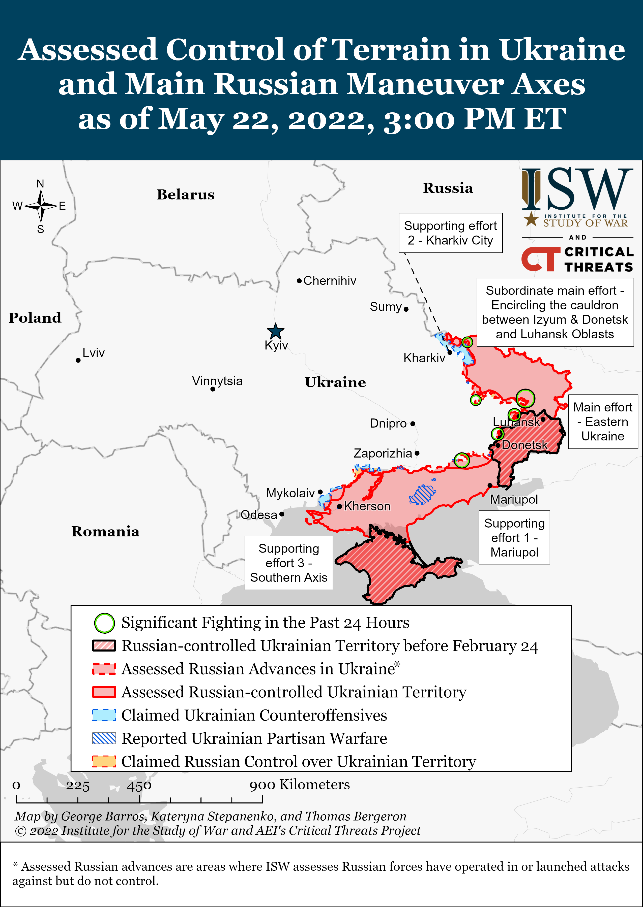 Russian forces continued to prepare to resume offensive operations southeast of Izium but did not make any confirmed advances on May 22.[2] The Ukrainian General Staff noted that Russian forces around Izium are creating conditions to resume offensive actions toward Sloviansk
Russian forces continued to prepare to resume offensive operations southeast of Izium but did not make any confirmed advances on May 22.[2] The Ukrainian General Staff noted that Russian forces around Izium are creating conditions to resume offensive actions toward Sloviansk
Russian forces continued ground assaults around Sievierodonetsk but did not make any confirmed advances in this area on May 22.[5] The Ukrainian General Staff reported that Russian troops conducted unsuccessful offensive operations around Oskolonivka, Purdivka, Schedryshcheve and Smolyianynove, all settlements to the east of Sievierodonetsk. These offensive operations are likely meant to encircle Sievierodonetsk from the east, supporting previous advances towards the city from the north (via Rubizhne), west (via Bilohorivka) and south (via Popasna).
Russian forces likely continued preparations for renewed offensives on the southern axis on May 22. The Ukrainian General Staff reported that Russian troops on this axis are focusing on building secondary lines of defense, strengthening air defense systems, conducting reconnaissance and shelling Ukrainian positions, all of which indicates they are setting conditions for subsequent offensive actions. The Ukrainian Resistance Center additionally reported instances of Ukrainian partisan activity targeting collaboration officials and Russian artillery systems in Enerhodar and Melitopol, indicating continued and organized Ukrainian resistance in occupied areas of Ukraine.
Key Takeaways
- Ukrainian sources confirmed that Russian forces have secured local advances to the north and west of Popasna since at least May 20. Russian forces likely seek to push further west toward Bakhmut and north to support the encirclement of Sievierodonetsk but remain unlikely to achieve rapid advances.
- Russian forces will likely attempt to hold positions west of the Siverskyi Donets River against Ukrainian attacks (rather than retreating across the river) to prevent further Ukrainian advances from threatening Russian lines of communication to Izium.
- Russian occupying forces continued filtration and deportation procedures in and around Mariupol.
- Russian forces are likely preparing to resume offensives on the southern axis.“
Consequences and what to do?
Putin is starving millions of people around the world, the Editorial Board of The Washington Post writes.
Vladimir Putin’s atrocities are growing by the day. In addition to having the blood of Ukrainians on his hands from his completely unjustified war, the Russian leader is also responsible for the growing starvation of people around the world. Ukraine is the breadbasket for much of the Middle East and North Africa. Right now, Mr. Putin is preventing Ukrainian grain from leaving the port of Odesa and along other key Black Sea routes. The result is dire: Global food prices are at an all-time high
and 276 million people are food insecure — more than double the numbers from 2019.
Sri Lanka is the latest example of just how devastating Mr. Putin’s global food crisis is becoming. The island nation has nearly run out of food and fuel. People are lining up for days for what little is still available. As one desperate father told Reuters, “Without food, we are going to die.” As food prices have skyrocketed since Mr. Putin’s invasion of Ukraine, Sri Lankans have not been able to afford the higher costs and the government does not have enough money to help. The country just defaulted on its debt for the first time in its history.
Mr. Putin’s next moves will decide whether much of the developing world experiences mass hunger and even famine this year and next. World leaders are urging the Russian leader to at least allow grain shipments out of Ukraine to help feed tens of millions of people in countries that rely heavily on imported food — such as Sri Lanka, Burkina Faso, Yemen, Sudan, Lebanon, Tanzania, Uganda, Egypt, Tunisia and Cameroon.
“If you have any heart at all for the rest of the world, regardless of how you feel about Ukraine, you need to open up those ports,” UN World Food Program head David Beasley said at the recent Society for Advancing Business Editing and Writing conference. Mr. Beasley’s team normally sources about half of its grain from Ukraine. “Millions of people around the world will die because these ports are being blocked.”
It turns out not only is Mr. Putin blockading shipments on the Black Sea, he has even had Russian ships steal Ukrainian grain and try to sell it, according to CNN. Many nations refused to buy the pilfered goods, but it appears the grain ended up in Syria, one of Mr. Putin’s few allies.
To their credit, other nations have stepped up to provide more money and food. The United States has already given $2.6 billion to help prevent the food crisis from turning into widespread famine and lawmakers just approved nearly $5 billion more for food and humanitarian needs as part of a Ukraine aid bill.
But with 20 million metric tons of grain and corn just sitting in storage at Ukrainian ports right now, there’s only so much the rest of the world can do. Mr. Putin’s war is on the verge of becoming Mr. Putin’s global famine.”
Moody's downgrades Ukraine's ratings and expects gradual economic recovery from 2023, the Ukrinform reports. Moody's has downgraded the Government of Ukraine's foreign and domestic currency long-term issuer ratings and foreign currency senior unsecured debt ratings to Caa3 from Caa2. Moody's has also changed the outlook to negative from ratings under review, concluding the review for downgrade that was initiated on 25 February 2022, reads the report released on the agency’s website.
“The downgrade of the ratings to Caa3 is driven by the increased risks to Ukraine's government debt sustainability from the invasion by Russia leading to a more protracted military conflict than Moody's initially expected, which increases the likelihood of a debt restructuring and losses being imposed on private-sector creditors,” Moody's experts explain. As noted, while Ukraine is benefitting from large commitments of international financial support, helping to mitigate immediate liquidity risks, the resulting significant rise in government debt is likely to prove unsustainable over the medium term. […]
It is underscored that the negative outlook reflects that there is still a high degree of uncertainty around how the invasion will evolve and its credit implications. A more protracted military conflict following the invasion by Russia would keep financing needs very high for a prolonged period and result in a further rise in the debt burden. Hence, the recovery by investors in the event of default could be lower than 65-80%, which would be consistent with a rating below Caa3, Moody's considers. […]
Moody's expects Ukraine’s real GDP to contract sharply by around 35% in 2022 given the heavy human toll, significant damage to Ukraine's productive capacity and infrastructure as well as the very large displacement of the population. Moody's estimates that those regions where fighting is ongoing or that are occupied by Russian troops accounted for around 20% of Ukraine's GDP prior to the invasion, given the concentration of agricultural and industrial activities. Moody's expects shelling will continue to hold back the return of significant economic activity during the remainder of the year. While Moody's expects the economy to gradually start to recover from 2023, Russia's invasion will likely cause some permanent loss in GDP even if significant external support is provided to help reconstruction.
“The more protracted military conflict will act as a drag on the government's financial resources, with Moody's estimating financing needs of around $50 billion (35% of 2022 GDP) for 2022 and forecasting a rise in government debt to around 90% of GDP from around 49% at the end of 2021,” reads the report.
Moody's estimates that international financial institutions and other donors have committed around $38 billion in financing support, of which $5 billion has so far been disbursed, since the start of the invasion which should cover a large portion of Ukraine's estimated financing needs for 2022.”
Hans Petter Midttun's assessment
As previously reported and as seen above, war carries huge economic consequences. The military effort has economic consequences. This includes financial reaction to the war, like the decline in GDP, loss of credit rating, higher national debt and taxes, higher inflation, currency depreciation which induced deposit outflows, the collapse of the banking sector, social costs (e.g. internally displaced personnel) and loss of international investments. The Ukrainian economy has been further weakened through the loss of minerals, coal, gas, oil, industry and infrastructure and through the cost of rebuilding the Security and Defence Sector.
The economic losses from the temporary occupation of the Crimean Peninsula alone were last year assessed to be $135 billion. This was a conservative estimate since it only lists known oil and gas deposits. The losses will increase by the year. According to the Advisor to the President of Ukraine on Economic Affairs, Oleh Ustenko, the amount of damage inflicted on Ukraine’s economy has reached about $1 trillion.
Additionally, the Russian maritime “blockade” of the Ukrainian ports in the Sea of Azov is continuing to have a devastating economic impact as it stops about 70% of the Ukrainian imports and exports. This blockade is also expected to have a huge impact on both global food security and costs.
More than $1 trillion in damages. More than 6,5 million refugees. More than 8 million persons are internally displaced. More than 660 children have been killed or wounded. More than 8,100 civilian casualties. More than 276 million people are food insecure. During the last week, direct losses to civilian infrastructure increased by $3.1 billion. At least 12 civilian airports, 295 bridges and bridge crossings, 591 kindergartens, 574 healthcare institutions, 108 religious and 179 cultural buildings, 169 warehouses and 19 shopping malls have been destroyed. 38,6 million square metres of residential buildings have been damaged or destroyed.
As of May 19, the total amount of direct documented infrastructure damages, based only on public sources, is $97.4 billion. Overall Ukraine’s economic losses since 24 February, taking into account both direct and indirect losses (GDP decline, investment cessation, the outflow of labour, additional defense and social support costs, etc), range from $564 billion to $600 billion.
These numbers will continue to grow until Russia is defeated. A ceasefire will result in a temporary reprieve only. Even more importantly, as repeatedly demonstrated, a ceasefire will unfortunately also result in a loss of Western focus, unity, and priority.

